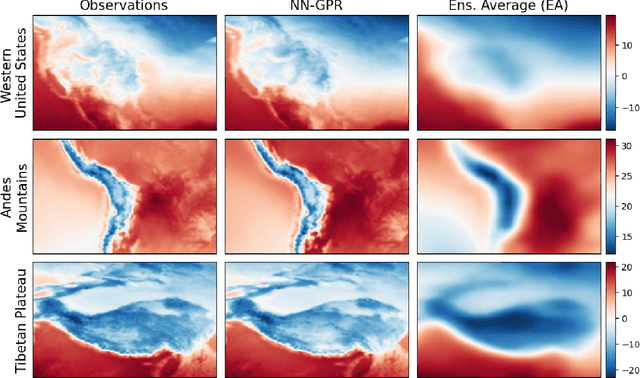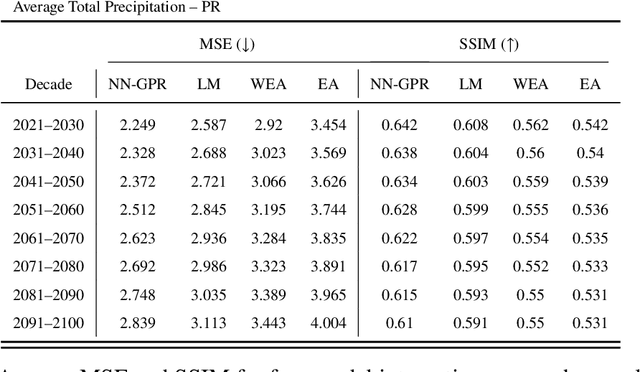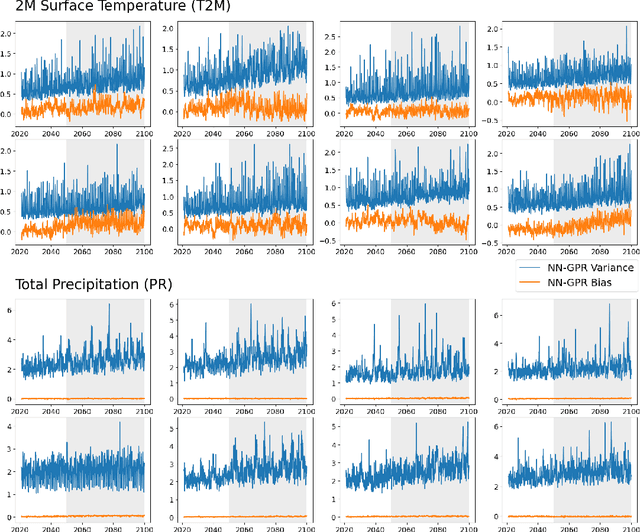Trevor Harris
Department of Statistics, Texas A&M University
Locally Adaptive Conformal Inference for Operator Models
Jul 28, 2025Abstract:Operator models are regression algorithms for functional data and have become a key tool for emulating large-scale dynamical systems. Recent advances in deep neural operators have dramatically improved the accuracy and scalability of operator modeling, but lack an inherent notion of predictive uncertainty. We introduce Local Spectral Conformal Inference (LSCI), a new framework for locally adaptive, distribution-free uncertainty quantification for neural operator models. LSCI uses projection-based depth scoring and localized conformal inference to generate function-valued prediction sets with statistical guarantees. We prove approximate finite-sample marginal coverage under local exchangeability, and demonstrate significant gains in adaptivity and coverage across synthetic and real-world operator learning tasks.
Quantifying uncertainty in climate projections with conformal ensembles
Aug 13, 2024Abstract:We introduce conformal ensembling, a new approach to uncertainty quantification in climate projections based on conformal inference. Unlike traditional methods, conformal ensembling seamlessly integrates climate models and observational data across a range of scales to generate statistically rigorous, easy-to-interpret uncertainty estimates. It can be applied to any climatic variable using any ensemble analysis method and outperforms existing inter-model variability methods in uncertainty quantification across all time horizons and most spatial locations under SSP2-4.5. Conformal ensembling is also computationally efficient, requires minimal assumptions, and is highly robust to the conformity measure. Experiments show that it is effective when conditioning future projections on historical reanalysis data compared with standard ensemble averaging approaches, yielding more physically consistent projections.
Validating Climate Models with Spherical Convolutional Wasserstein Distance
Jan 26, 2024



Abstract:The validation of global climate models is crucial to ensure the accuracy and efficacy of model output. We introduce the spherical convolutional Wasserstein distance to more comprehensively measure differences between climate models and reanalysis data. This new similarity measure accounts for spatial variability using convolutional projections and quantifies local differences in the distribution of climate variables. We apply this method to evaluate the historical model outputs of the Coupled Model Intercomparison Project (CMIP) members by comparing them to observational and reanalysis data products. Additionally, we investigate the progression from CMIP phase 5 to phase 6 and find modest improvements in the phase 6 models regarding their ability to produce realistic climatologies.
Fuel Consumption Prediction for a Passenger Ferry using Machine Learning and In-service Data: A Comparative Study
Oct 23, 2023



Abstract:As the importance of eco-friendly transportation increases, providing an efficient approach for marine vessel operation is essential. Methods for status monitoring with consideration to the weather condition and forecasting with the use of in-service data from ships requires accurate and complete models for predicting the energy efficiency of a ship. The models need to effectively process all the operational data in real-time. This paper presents models that can predict fuel consumption using in-service data collected from a passenger ship. Statistical and domain-knowledge methods were used to select the proper input variables for the models. These methods prevent over-fitting, missing data, and multicollinearity while providing practical applicability. Prediction models that were investigated include multiple linear regression (MLR), decision tree approach (DT), an artificial neural network (ANN), and ensemble methods. The best predictive performance was from a model developed using the XGboost technique which is a boosting ensemble approach. \rvv{Our code is available on GitHub at \url{https://github.com/pagand/model_optimze_vessel/tree/OE} for future research.
* 20 pages, 11 figures, 7 tables
Forecasting West Nile Virus with Graph Neural Networks: Harnessing Spatial Dependence in Irregularly Sampled Geospatial Data
Dec 21, 2022



Abstract:Machine learning methods have seen increased application to geospatial environmental problems, such as precipitation nowcasting, haze forecasting, and crop yield prediction. However, many of the machine learning methods applied to mosquito population and disease forecasting do not inherently take into account the underlying spatial structure of the given data. In our work, we apply a spatially aware graph neural network model consisting of GraphSAGE layers to forecast the presence of West Nile virus in Illinois, to aid mosquito surveillance and abatement efforts within the state. More generally, we show that graph neural networks applied to irregularly sampled geospatial data can exceed the performance of a range of baseline methods including logistic regression, XGBoost, and fully-connected neural networks.
Multi-model Ensemble Analysis with Neural Network Gaussian Processes
Feb 08, 2022



Abstract:Multi-model ensemble analysis integrates information from multiple climate models into a unified projection. However, existing integration approaches based on model averaging can dilute fine-scale spatial information and incur bias from rescaling low-resolution climate models. We propose a statistical approach, called NN-GPR, using Gaussian process regression (GPR) with an infinitely wide deep neural network based covariance function. NN-GPR requires no assumptions about the relationships between models, no interpolation to a common grid, no stationarity assumptions, and automatically downscales as part of its prediction algorithm. Model experiments show that NN-GPR can be highly skillful at surface temperature and precipitation forecasting by preserving geospatial signals at multiple scales and capturing inter-annual variability. Our projections particularly show improved accuracy and uncertainty quantification skill in regions of high variability, which allows us to cheaply assess tail behavior at a 0.44$^\circ$/50 km spatial resolution without a regional climate model (RCM). Evaluations on reanalysis data and SSP245 forced climate models show that NN-GPR produces similar, overall climatologies to the model ensemble while better capturing fine scale spatial patterns. Finally, we compare NN-GPR's regional predictions against two RCMs and show that NN-GPR can rival the performance of RCMs using only global model data as input.
 Add to Chrome
Add to Chrome Add to Firefox
Add to Firefox Add to Edge
Add to Edge